When I’m in the field photographing birds I have to constantly remind myself to avoid making assumptions.
Over the years I’ve spent a lot of time in Idaho and Montana during the breeding season photographing Williamson’s Sapsuckers and Red-naped Sapsuckers bringing food to their youngsters in their nest cavities. During most of the year both species feed mainly on tree sap but during the breeding season they switch primarily to insects to feed their offspring because growing youngsters need protein and fat. Lots of it.
In the past I’ve admitted to my blog followers that I’m a creature of habit because I feel comfortable with routine. So by nature I tend to make assumptions and that tendency sometimes leads me astray. For the first summer or two while I was photographing sapsuckers feeding youngsters virtually every time I could identify the insects that were brought to the nest they turned out to be ants. So eventually I became lackadaisical and just assumed that the food load for chicks was always ants.
That was a mistake. I should have known better – the word “always” is a trap waiting to be sprung.
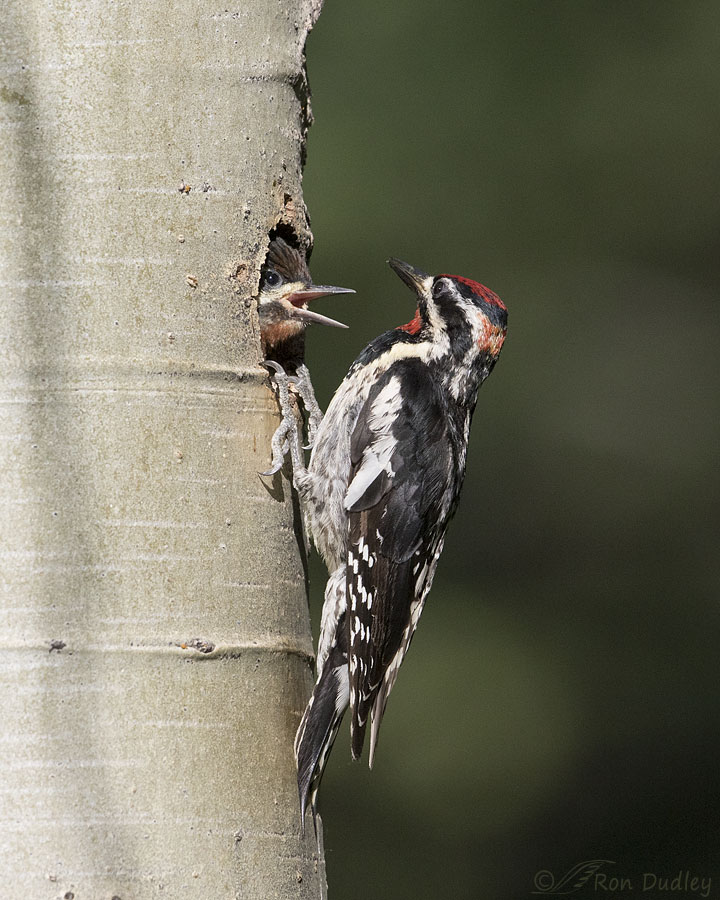
This is a female Red-naped Sapsucker at the nest cavity. When they have youngsters the adults usually have food in their bills when they show up at the nest but this time she didn’t. So the young sapsucker became impatient for something to eat and poked most of its head out of the cavity.
When they’re this age if I can see anything at all of the chicks its often only their bills so getting this photo was a treat, even though the adult is looking slightly away. .
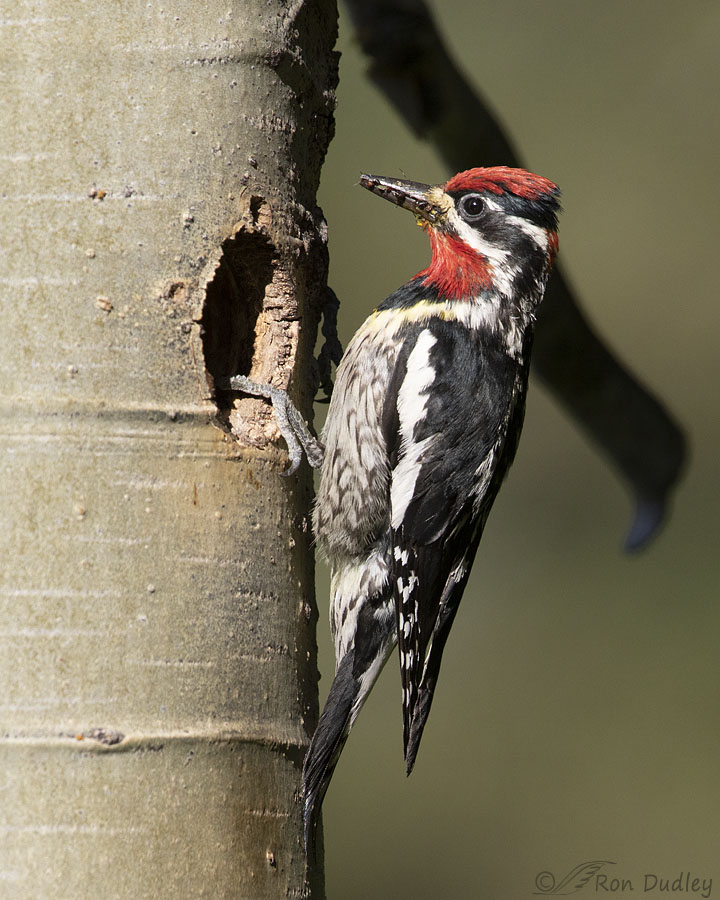
This trip to the nest cavity was more typical. The chick stayed hidden away in the cavity and the adult, in this case the male, had a bill-full of ants. Often they had far more ants in their bills than this and many of them were still alive.
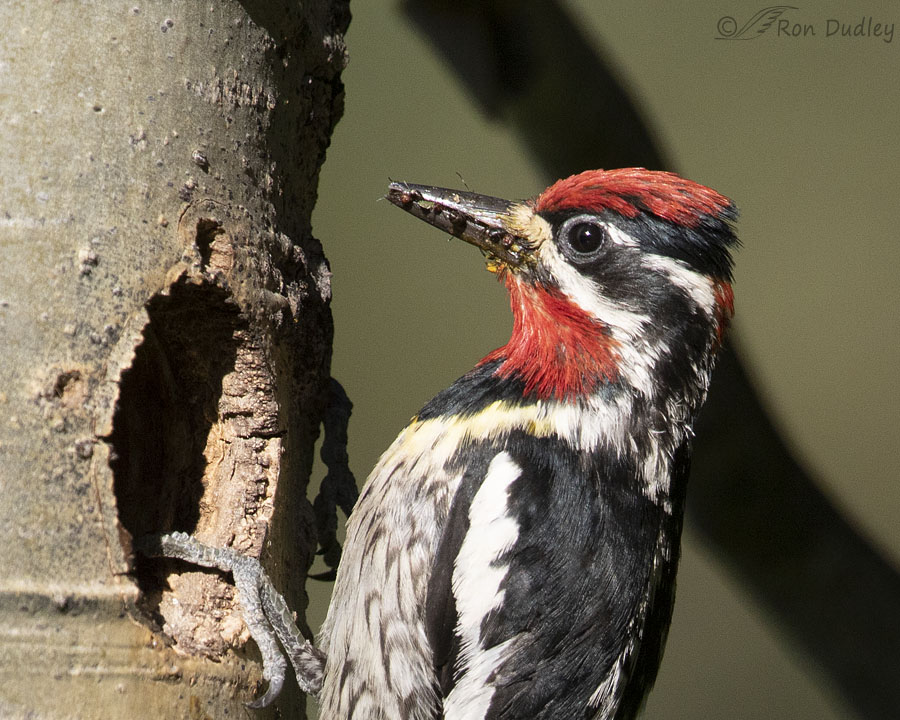
A tight crop of the same photo confirms that they’re ants. Occasionally one or more of them would escape and be crawling over the bill or the face of the adult but this time they all appear to be well secured.
But after I got home from that trip and looked more carefully at my images I realized that on at least one occasion the food delivered to the chicks in the cavity wasn’t ants.
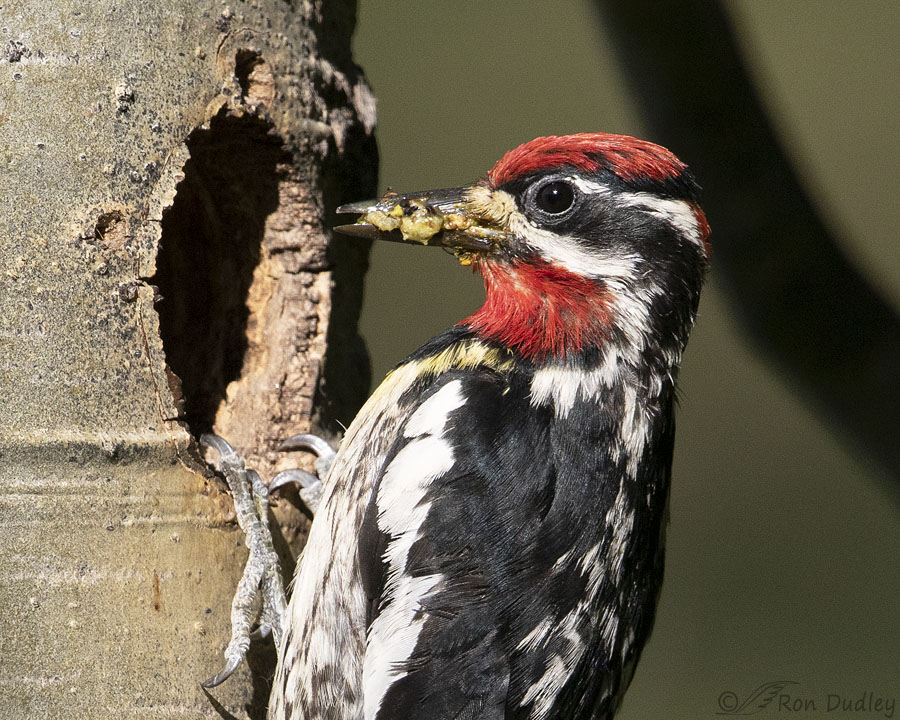
In this case it appears to be mashed up grubs and/or small caterpillars. A little research confirmed that “adults often crush prey items prior to feeding young”. Doing so is obviously messy but it prevents insects from escaping and crawling all over the inside of the nest cavity.
I know, big deal. So what if they occasionally feed their offspring insects other than ants? To me it doesn’t matter a lot but it does matter. When it comes to bird behaviors I take some pride in paying attention to detail so I hate it when I settle into a comfortable routine and make assumptions that turn out to be false.
At the ripe old age of 73 this old dog is still trying to learn new tricks. With varying success.
Ron
Notes:
- For those who may be curious about how to determine sex in adult Red-naped Sapsuckers. For me the most obvious field mark is the black border around their red nape. In males the black border around the larger red nape is incomplete. In females the black border around the smaller red area of the nape tends to be complete.
- During the breeding season Williamson’s Sapsuckers are even more dependent on ants as a food source than Red-naped Sapsuckers are.
- Adult sapsuckers with food for their chicks often visit their sap wells and dip the insects in sap before delivering them to their chicks. After all, who doesn’t like a tasty sauce over their main course?


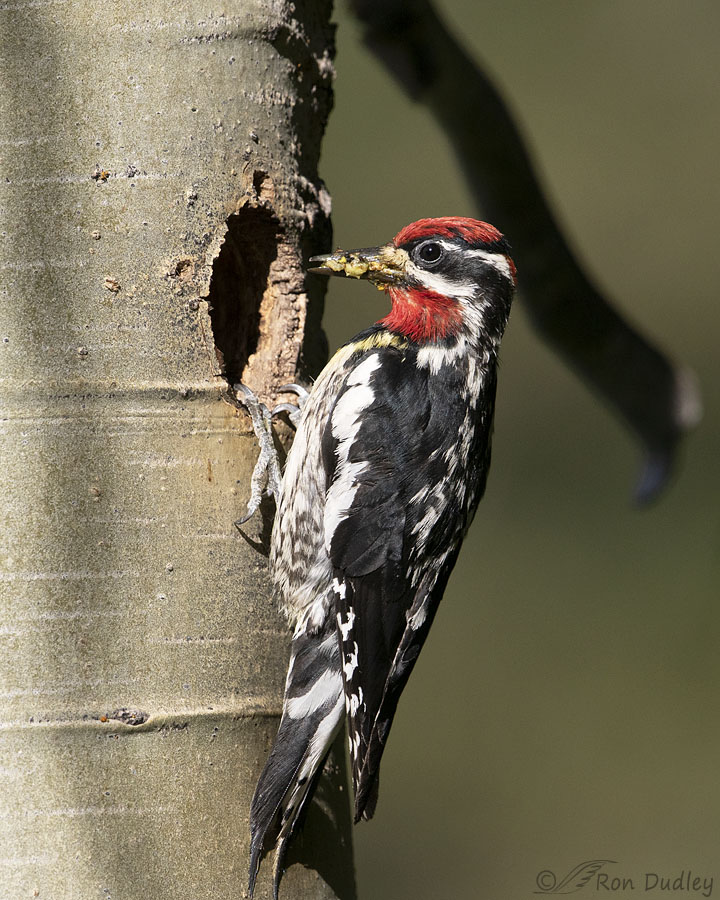
Those are some juicy *gulp* morsels. I had to giggle at the impatient and hungry baby.. “Whadja bring me, Mom?” “Sorry, Kiddo. Nothing this time.” “Awww, nuts!”
Ron, I ALWAYS find something interesting in your blog posts and I NEVER want you to stop being you. 😉 (That’s as far as I’ll hedge my bets. Hubby and I have learned our lesson with using always and never — especially as we’ve gotten older and our memories are more and more like sieves every day.)
I like your hedged bets, Marty. So far I think my memory is holding up pretty reasonably well but this beaten-up old body is another story.
Hey! Ron, your photos for sure, but also love ya’ for the obs and details…
Thank you, Susan.
Thanks for pointing out the sexual dimorphism. Took me awhile to see, but the photos got me there.
If I could go back and test all the absolutes and assumptions I’ve made…
Today’s blog and Dan Gleason’s article on mealworms point out the importance of a varied diet. I mean, I love tofu, but if that’s all I ate I would “always” have dietary deficiencies, and “never” a balanced diet. At least, I “assume” I would.
OK, here come the tofu jibes.
Can’t resist – I’d rather eat ants than bean turds…
😂
I wouldn’t.
C’mon, EC. At least with their formic acid ants have a little spice and character…
My partner (who coined the phrase bean turd) would agree with you. I like the blank canvas and my tofu meals are NOT lacking in character or flavour.
Now, now, you two get along. Perhaps share a bowl of tofu sprinkled with ants. And mealworms.
We always get along, Lyle. But if we share that bowl of gruel I ain’t touchin’ that tofu…
Lyle, I’ll come to your tofu party! Especially if I can bring some Sambol!
Always and never are dreadful traps aren’t they? Speaking for myself I would be mashing those ants as thoroughly as the caterpillars if I was one of those diligent parents. The thought of ants crawling over my face gives me the grues. Not helped because I come up in humungous welts if any of the vicious beasts fangs me.
Thank you for continuing my education.
EC, I love trying to figure out some of your Aussie phrases and terms. This time it was ‘grues’. If I focused on the right definition when I looked it up its origin is Scottish…So thanks for MY ‘continuing education’… 🙂
In our family at least the grues is short for a gruesome feeling. And the thought of small insects running over my face is certainly that. One of my MS symptoms (fortunately rare) is feeling that I have insects on my face. NOT good days, despite it being a very minor issue.
What I found was “a shudder of fear” – Scottish.
Yup. And that sums it up well.
Lovely images and yes I like to know what they are eating also. In fact I just photographed a Downy woodpecker yesterday with specific intent to see what is was eating. I will post a photo and you can give your 2 cents worth.
Looking forward to it, April. But my 2 cents is usually worth less than 2 cents…
I assumed a lot of things about birds until I found your blog. This is why I enjoy following you… your beautiful pictures and the story behind them 😁
As for the words “never” and “always” I usually only use them when talking to my husband ❗️
Have a good day 🌞
“As for the words “never” and “always” I usually only use them when talking to my husband”
I’ll be smiling over that one for a good long time this morning, Diana!
“Always” and “Never” DO tend to get one in trouble! 😉 Quite using “never” MANY years ago tho “always” still creeps in now and then…..
Guess it depends on what’s readily available and dipping the ants in sap may also slow them down a bit……😀 Northern Flickers regularly dig in ant hills tho usually mid-summer here.
Wonderful pictures of the action…….😀
Meant “quit”…..
Judy, “Always” always gets me into trouble… 🙂
Really liked all of these photos, especially the first–chick with its wide-open mouth…..started wondering how the adult would even catch–let alone secure-
a bill full of crawling ants? Then wondered if the sapsucker visits a source
of sap FIRST, getting its bill all sticky, and then dives into a bunch of ants ?
A sticky beak would be attractive to ants, and then “glue” them to the delivery
system; have you had occasion to watch the sequence of gathering before feeding ?
Kris – No, I’ve never been able to observe them gathering ants. I try to watch where they go but it’s usually in different directions and too far away through thick trees for me to see where they’re getting them.
But when I researched the behavior it said that they “dip the ants in sap” or words to that effect so I suspect (but don’t assume… 🙂 ) they don’t gather the sap before they do the ants.
I always tell myself to remember that birds are not automatons, and that hunger begs to be satisfied. Assumptions always bite me in the butt, no matter what the subject is. Love these shots!
Thanks, Sallie. Same with me, I have multiple bite marks as evidence…
Another excellent educational series. And a good reminder to limit the use of the words always and never. I was just taking photos of one of these Sapsuckers the other day at a cavity, but at the angle I could not see if she was carrying food or if there was a chick. Do you know if both female and male Sapsuckers feed the chicks?
Thanks Everett. Yes both adults feed their chicks. Between the two of them they average about one trip to the nest every 7 minutes all day long so it’s a good thing both parents are involved or the one feeding the chicks would probably perish from exhaustion…
I love this story! Insects and birds are fascinating to millions of folks, thx for adding to the fascination 🙂
Good. Thanks, Terri.